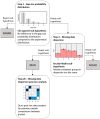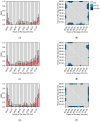Missing Data Statistics Provide Causal Insights into Data Loss in Diabetes Health Monitoring by Wearable Sensors
- PMID: 38475061
- PMCID: PMC10935383
- DOI: 10.3390/s24051526
Missing Data Statistics Provide Causal Insights into Data Loss in Diabetes Health Monitoring by Wearable Sensors
Abstract
Background: Data loss in wearable sensors is an inevitable problem that leads to misrepresentation during diabetes health monitoring. We systematically investigated missing wearable sensors data to get causal insight into the mechanisms leading to missing data.
Methods: Two-week-long data from a continuous glucose monitor and a Fitbit activity tracker recording heart rate (HR) and step count in free-living patients with type 2 diabetes mellitus were used. The gap size distribution was fitted with a Planck distribution to test for missing not at random (MNAR) and a difference between distributions was tested with a Chi-squared test. Significant missing data dispersion over time was tested with the Kruskal-Wallis test and Dunn post hoc analysis.
Results: Data from 77 subjects resulted in 73 cleaned glucose, 70 HR and 68 step count recordings. The glucose gap sizes followed a Planck distribution. HR and step count gap frequency differed significantly (p < 0.001), and the missing data were therefore MNAR. In glucose, more missing data were found in the night (23:00-01:00), and in step count, more at measurement days 6 and 7 (p < 0.001). In both cases, missing data were caused by insufficient frequency of data synchronization.
Conclusions: Our novel approach of investigating missing data statistics revealed the mechanisms for missing data in Fitbit and CGM data.
Keywords: activity trackers; biomedical sensors; continuous glucose monitoring; health monitoring; heart rate; missing data; signal processing; vital signs; wearable sensors.
Conflict of interest statement
The authors declare no conflicts of interest.
Figures






Similar articles
-
Continuous Monitoring of Vital Signs With Wearable Sensors During Daily Life Activities: Validation Study.JMIR Form Res. 2022 Jan 7;6(1):e30863. doi: 10.2196/30863. JMIR Form Res. 2022. PMID: 34994703 Free PMC article.
-
Activity Tracker-Based Metrics as Digital Markers of Cardiometabolic Health in Working Adults: Cross-Sectional Study.JMIR Mhealth Uhealth. 2020 Jan 31;8(1):e16409. doi: 10.2196/16409. JMIR Mhealth Uhealth. 2020. PMID: 32012098 Free PMC article.
-
A Markov Model of Gap Occurrence in Continuous Glucose Monitoring Data for Realistic in Silico Clinical Trials.Comput Methods Programs Biomed. 2023 Oct;240:107700. doi: 10.1016/j.cmpb.2023.107700. Epub 2023 Jun 28. Comput Methods Programs Biomed. 2023. PMID: 37437469
-
Data management and wearables in older adults: A systematic review.Maturitas. 2019 Jun;124:100-110. doi: 10.1016/j.maturitas.2019.03.012. Epub 2019 Mar 18. Maturitas. 2019. PMID: 30910279
-
Consumer-Based Wearable Activity Trackers Increase Physical Activity Participation: Systematic Review and Meta-Analysis.JMIR Mhealth Uhealth. 2019 Apr 12;7(4):e11819. doi: 10.2196/11819. JMIR Mhealth Uhealth. 2019. PMID: 30977740 Free PMC article.
Cited by
-
Data Synthesis Reinvented: Preserving Missing Patterns for Enhanced Analysis.IEEE Trans Knowl Data Eng. 2025 Jul;37(7):3962-3975. doi: 10.1109/tkde.2025.3563319. Epub 2025 Apr 22. IEEE Trans Knowl Data Eng. 2025. PMID: 40727435
-
Consequences of Data Loss on Clinical Decision-Making in Continuous Glucose Monitoring: Retrospective Cohort Study.Interact J Med Res. 2024 Jul 31;13:e50849. doi: 10.2196/50849. Interact J Med Res. 2024. PMID: 39083801 Free PMC article.
-
Investigation of the inhibitory potential of secondary metabolites isolated from Fernandoa adenophylla against Beta-glucuronidase via molecular docking and molecular dynamics simulation studies.PLoS One. 2025 May 23;20(5):e0324100. doi: 10.1371/journal.pone.0324100. eCollection 2025. PLoS One. 2025. PMID: 40408389 Free PMC article.
-
Participant-Centered Engagement for Sustained Adherence to Smartwatches: A 12-Month Prospective Decentralized Digital Health Study.Clin Transl Sci. 2025 Feb;18(2):e70155. doi: 10.1111/cts.70155. Clin Transl Sci. 2025. PMID: 39954233 Free PMC article.
References
-
- Peters A., Cohen N., Calhoun P., Ruedy K.J., Beck R.W., Martens T.W., Bao S., Njeru N.M., Beck S.E., Price D.A. Glycaemic Profiles of Diverse Patients with Type 2 Diabetes Using Basal Insulin: MOBILE Study Baseline Data. Diabetes Obes. Metab. 2021;23:631–636. doi: 10.1111/dom.14238. - DOI - PMC - PubMed
MeSH terms
Substances
Grants and funding
LinkOut - more resources
Full Text Sources
Medical
Miscellaneous

